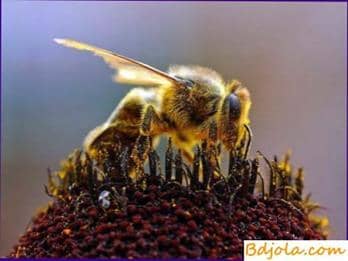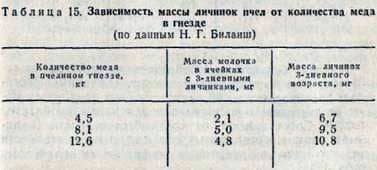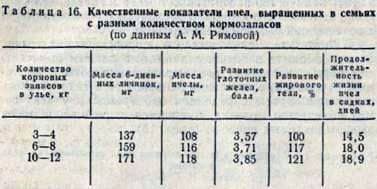
Bees always collect nectar, if there are blooming melliferous plants that release nectar, and if the weather does not interfere with their flights (rain, strong wind, low temperature). However, in the spring, the arrival of fresh nectar (and pollen) can not fully satisfy the family’s need for brood rearing, and the missing bee’s food is replenished by the remaining stocks after winter. The lack of honey in hives in the spring leads to a decrease in the number of larvae grown and a reduction in the strength of families to basic honey.
Caring for the full feeding of bee colonies, it is necessary to take into account two circumstances:
1. The quantity of prepared fodder reserves becomes especially important in connection with the extreme instability of early spring honey harvest. In some years bees can be satisfied with small stocks, for example 6 kg. But in years with a cold, unfavorable spring, reserves will need 1.5-2 times more. Since it is impossible to foresee in advance what spring will be like, how the spring melliferous plants will develop and to what extent the weather will allow them to gather nectar and pollen from them, then the beekeeper should be provided with the family for the unfavorable conditions of weather and honey collection, only then can be guaranteed that the bees families will be able to grow stronger to the main honey collector.
2. Even before the invention of the framework beehive, beekeepers talked and wrote about the need to build up in beehives not only a lot of bees, but necessarily “well-fed”, heavy, well-developed bees capable of producing a lot of nectar for one. In our time, this advice has acquired a scientific justification: bees are reflexively influenced by the amount of sealed honey in the nest, if it is small, then the bees economize it, growing bees with a reduced ability to work.
Two experiments were conducted at the Institute of Apiculture. In the first experiment, families equipped with different amounts of food were put up for cultivation of a honeycomb with bee brood, which was completely homogenous in genetic terms. Then, at the same time, the number of milk available in the cells and the weight of the larvae fed were determined simultaneously in all families (Table 15).

If there were 8-12 kg honey in the nests, the bees supplied the larvae with a much larger amount of food and the larvae had a reliably greater mass.
The second experience lasted throughout the spring-summer season. At the same time, there were formed in the early spring 3 completely equal groups of 10 bee colonies. The families of the I group left 3-4 kg of honey from the spring, the families of Group II-6-8 and III-10-12 kg of honey, the prescribed amounts of feed were maintained throughout the whole spring. All the families had the same number of perga. Bees were able to bring from the field a completely identical amount of fresh nectar and pollen.
Experience has shown that the presence of large stocks of food reacts reflexively to bees: they increased brood more (by 24%), fed their larvae better and raised more valuable bees (Table 16). To the beginning of the main honey collection, families with large food reserves had significantly more bees. During the period of the main honey collection, families with small stocks collected an average of 26.9 kg of honey, and with large ones – 40.5 kg (for 1 kg of bees – respectively, 8.7 and 10.5 kg).

The importance of large feed supply of bee colonies is convincingly demonstrated by the data collected by the Institute of Apiculture in 188 beekeeping farms of the honey-pollinating direction of the central regions. Comparison of their feed supply (the amount of feed left from autumn) and productivity showed a direct relationship between these values (Table 17).

In the apiary, where the reserves of honey were 14-16 kg, families collected 17-24 kg of honey; in another group of apiaries located in the same areas with the same honeybase, but from families provided with 18-20 kg – 28-35 kg of honey (there were 58 apiaries in the register).
In hives in the spring there should be not less than 10-12 kg of honey printed in cells and not less than two complete honeycombs with perga. In order to have such stocks in the spring, it is necessary to prepare 25-30 kg of honey per family, going to winter, during the harvest of the previous year. It is not necessary to leave all the prepared forage for the winter in the hives – a part of it that is not required in winter, can be stored in the warehouse and substituted in hives in the spring.
Bees will not consume excess honey. In cases of favorable weather in the spring and good honey harvest, excess honey will remain in the hive; It can be pumped out before the start of the main honey collection to replace freshly collected.
With a lack of food in the hives and the lack of spare honey combs, feeding bees with sugar is used. However, feeding with sugar does not give such results as setting honey honeycombs.
In large beekeeping farms beekeepers in the spring tend to do without feeding bees. Large stocks of forage in honeycombs left over from last year, guarantee the successful growth of families and save the beekeeper from the laborious work of preparing and distributing sugar syrup to bees. In addition, because of bad weather, this work can not always be done in a timely manner.
Цвета пчелиного улья. Дезинфекция пчелиных рамок.
Feeding base of beekeeping